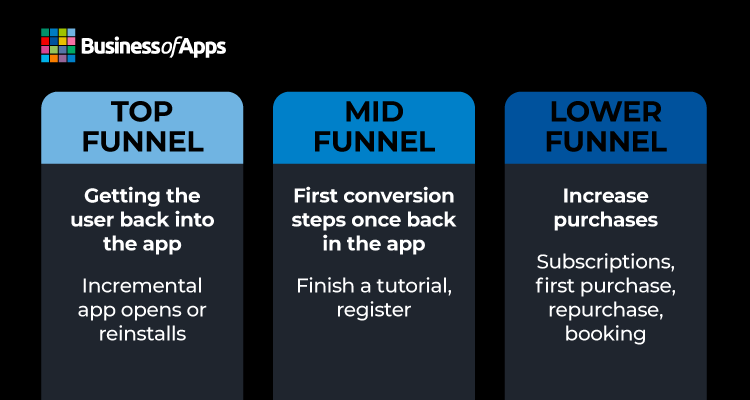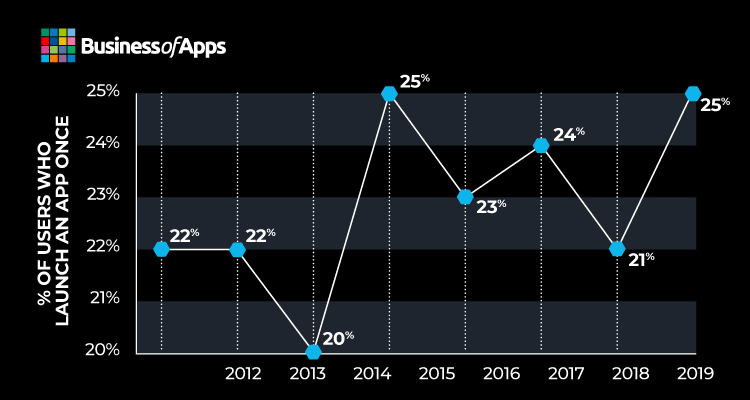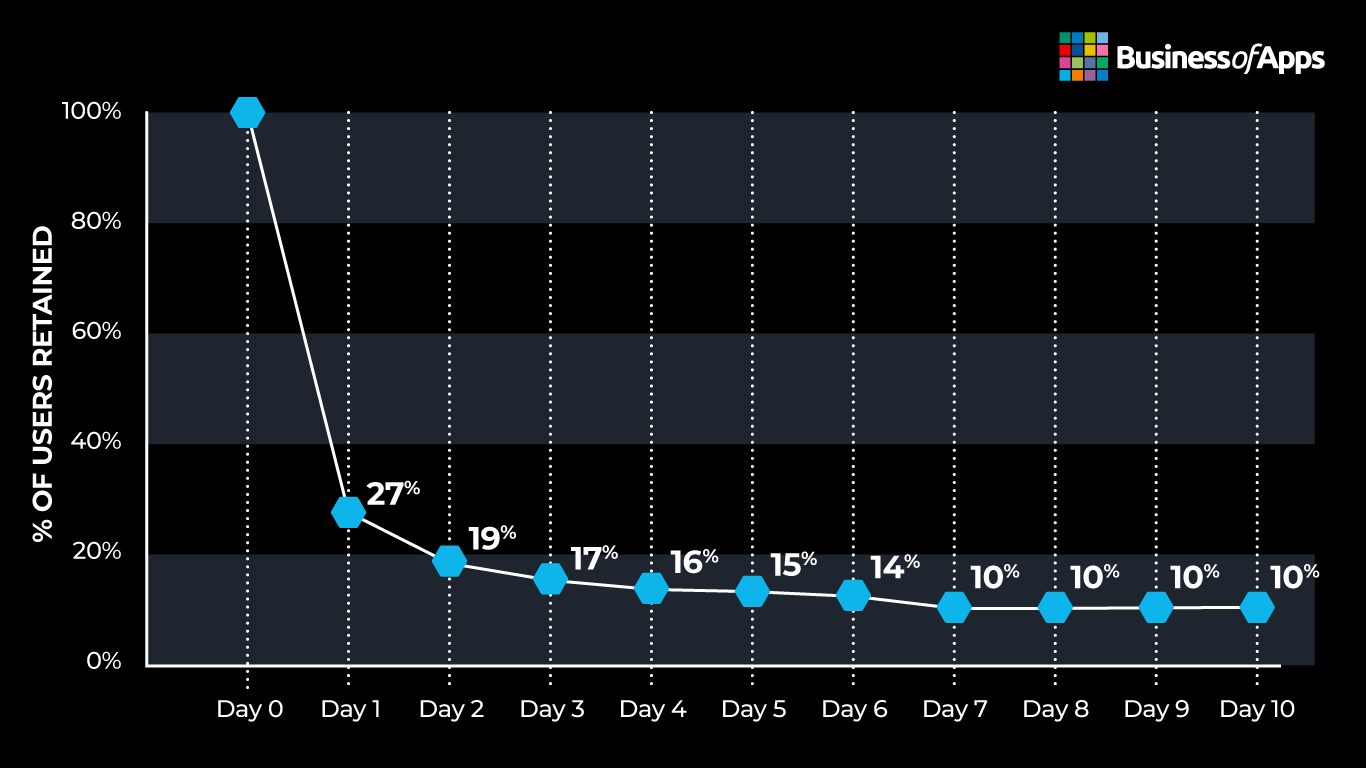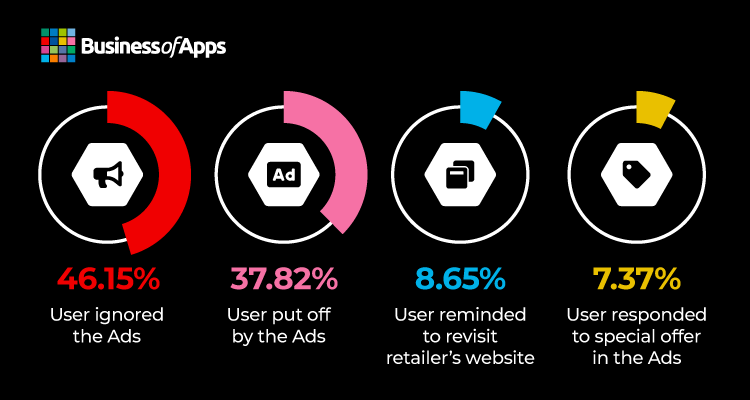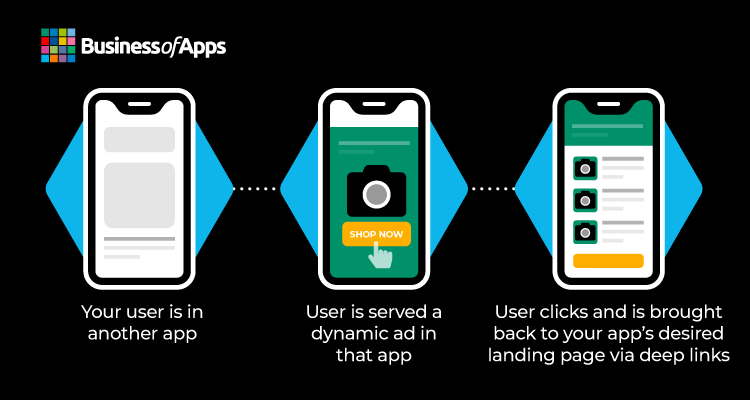Mobile apps represent a huge opportunity for businesses today. They let you showcase your brand in the best possible light, allow you to engage with your customers wherever they are and at any time of the day, and help you build long-lasting relationships with them. It’s hardly a surprise that in 2022 alone, there were 255 billion app downloads and the app industry is expected to generate over $935 billion in revenue in 2023.
But developing epic app experiences and getting initial traction and recognition are only half the story. Users are, indeed, downloading more apps than ever before but they are not using them all. The average user has around 80 apps downloaded on their phone, so most users just don’t have the time to engage with all the apps they have. In fact, 73% of mobile app users churn after 90 days on average. So, what happens when a user’s attention inevitably drifts to other apps?
Well, that’s where app retargeting comes into play. Even if a user churns, it’s not necessarily a lost battle. There are always effective methods you can use to re-engage them and bring them back to your app.
In this guide, I will walk you through the world of mobile app retargeting. We will start by defining the concept before having a look at the benefits of retargeting. We will then explore the most effective retargeting strategies to make your app the center of attention again, learn how to incorporate app retargeting into your long-term growth strategy, and see how the best in the field are handling app retargeting. We will also talk about retargeting campaigns in light of Apple’s ATT and Google’s likely deprecation of GAID to get you ready for the privacy-first future. So, without further ado, let’s get started.
What is app retargeting?
Mobile app retargeting or simply app retargeting refers to the practice of delivering personalized ads to users who have previously interacted with, visited, or installed your mobile app. The main goal of app retargeting is to re-engage users in various ways, such as encouraging them to revisit your app’s content, reinstall the app if they have previously uninstalled it, or complete specific actions within the app, like finalizing a purchase that was previously abandoned.
App retargeting user journey
The essence of app retargeting lies in employing customized strategies to entice users to re-engage with your app and guide them through the complete user journey. Leveraging insights gained from previous interactions with users provides valuable knowledge about their preferences and interests. By understanding why they may have sought similar services elsewhere, you can tailor your retargeting efforts accordingly.
Retargeting campaigns aim to remind customers of your brand, put your app top of mind, and cultivate positive in-app behaviors that result in improved user retention and increased conversions. By leveraging retargeting, you can break through the noise generated by all the other apps on a user’s phone and inspire desired actions within your app.
FAQ: Differentiating remarketing and retargeting
- Remarketing encompasses all efforts to bring a user back to an app, webpage, or product. It’s not specific to mobile apps and can include anything from email and push notifications to influencer marketing.
- Retargeting, on the other hand, is a strategy within the larger notion of remarketing. It employs real-time bidding to serve personalized ads to users, encouraging them to return to an app and complete desired actions.
User Acquisition Buyer's Guide
Download our User Acquisition Buyer’s Guide to get a full list of the best service providers on the market to choose from. The guide also covers what is a user acquisition company and how to choose the right one.
Now that we have a solid understanding of the concept, let’s dive a little deeper into the app retargeting realm.
Key data points
Mobile app retargeting at a glance:
- Brand awareness is the reason 70% of marketers opt for retargeting.
- Retargeting reduces cart abandonment by 6.5%.
- 68% of marketing agencies and 49% of brands have a dedicated budget for retargeting.
- 17.5% of apps running retargeting see a 25% conversion rate.
- Retargeting beats all other ad placement strategies with a 1,046% efficiency rate.
- The appeal of a product is the main reason for 37% of customers to click a retargeted ad.
With more than 2.24 million apps available on the Apple App Store and 2.63 million on the Google Play Store, the competition is enormous. It’s no longer enough to just acquire a user, you have to keep them engaged to ensure they stay hooked into your app and regularly come back for more.
App abandonment
Source: Localytics
In this hyper-competitive app space, it is no wonder that apps are having a hard time acquiring and retaining users. With too many competitors to count and increasingly high user expectations, an app that does not quickly deliver on all fronts will simply not be used and will eventually be deleted.
Mobile app retention by platform, Q3 2021 (in %)
It’s no surprise then that 73% of mobile app users churn after 90 days on average. The problem gets further compounded when you consider that one-fourth of all users abandon an app after just one use.
Retention rate (in %) on Day 30 of mobile app installs worldwide in 3rd quarter 2022, by category
With users abandoning apps at a record rate and retention harder and more expensive than ever before, retargeting efforts become an easy and obvious solution to ensure your user acquisition spend doesn’t go to waste.
Source: Systango
And the numbers are telling a very clear story about how effective mobile app retargeting can be.
With 27%, eCommerce retailers are at the top of the list of industries that use this strategy the most. Media follows with 17%, technology and healthcare both rank third with 10%, and finance comes in fourth with 9%.
Industries that use retargeting the most (in %)
Retargeting CTR statistics indicate that retargeting ads generate an average click-through rate of 0.7% and have a 70% higher conversion impact on users, proving the effectiveness of retargeting as a re-engagement strategy.
How retargeting ads affect purchase decisions
Source: InvespCRO
Statistics for mobile also show that retargeting not only reduces shopping cart abandonment but also increases online sales by 20%.
Most people engage with retargeted ads because they are attracted to the product displayed, with the product’s appeal being the main reason for 37% of customers to click a retargeting ad. According to Linear Design, 58% of online shoppers mainly notice ads for familiar products, and 40% of sales revenue is generated from remarketing or repeat customers.
Engagement retargeting also increases conversion rates by 70% because it works well with rich media, flash, and videos. Retargeting ads also work especially well during holiday seasons.
Finally, statistics also show that only 11% of online shoppers do not like seeing retargeted ads, while 30% react positively to them.
Consumer concern after seeing retargeting ads (in %)
As you can see from the graph above, 10.05% of people are not concerned about seeing a retargeting ad, while 29.41% are indifferent to it. Only 18.87% are actually concerned.
Why is app retargeting important?
App retargeting offers a multitude of advantages that extend beyond mere user engagement and initial app downloads. Let’s explore the benefits you can reap by implementing mobile app retargeting.
Drive engagement
App retargeting increases app visits and encourages in-app activities, resulting in enhanced user engagement.
Boost app user retention
By increasing app visit frequency and reducing churn, app retargeting helps improve user retention rates.
Increase brand awareness
Retargeting campaigns increase brand exposure and help you build long-lasting customer relationships.
Increase conversion rates
App retargeting leads to a rise in in-app conversions, sign-ups, and purchases, contributing to overall business growth.
Reach warm leads
By targeting individuals who have already shown interest in your products, services, or features, app retargeting enables you to focus your efforts on a receptive audience.
Convert existing users into paying customers
Retargeting prompts existing users to progress along the sales funnel, transforming them into paying customers.
Gain audience insights
Retargeting provides valuable analytics, showing you where your conversions are being recaptured after users leave your app. These insights can inform future marketing strategies and help drive traffic.
By leveraging the power of app retargeting, you can drive engagement, increase conversions, build customer loyalty, and gain valuable insights into your audience, ultimately contributing to the long-term success of your mobile app.
How does retargeting work?
So, now that we know what app retargeting is and what its benefits are, let’s have a look at how it actually works. The process can be quite complicated, and any in-depth explanation will inevitably be ridden with a bunch of technical terms, but, in short, here’s how retargeting works.
The user journey begins with a user downloading your app and recording their first session within it.
Data on their in-app activity is then collected. This includes information on what products they looked at, what pages they visited, what content/features/services piqued their interest the most, and also which level of the user onboarding they reached and how far they made it through the subscription funnel (if the app has one).
This data allows you to segment users into distinct cohorts, which can then help you decide how to retarget each user group, where to retarget them, when to retarget them, and what kind of ads to use.
To prevent a user from becoming inactive or to encourage them to follow through with another in-app event (i.e., complete registration, follow through with onboarding, finish tutorial, finalise a purchase, etc.), retargeting campaigns will generally serve up your targeted ad within another app’s ad space.
These highly personalized, dynamic ads will contain a call-to-action specifically tailored to that user’s position within your funnel. Once they click, they’ll be directed to the specific point in your app where they left off.
Retargeting ads will generally be deep linked, which allows a user to be directly sent to the page in your app where they left off, instead of being directed to the home page. If they have previously uninstalled your app, they will be redirected to the app’s App Store/Google Play Store page to download and install it again.
Want to learn more about deep links? Check out our guide covering everything you need to get started with deep linking.
Retargeting step-by-step
A practical example
Knowing how retargeting ads work is all fine and dandy, but seeing how things work in practice can’t hurt either.
Let’s say you have a travel app. A user downloads your app and conducts a search on your app for flights departing around the end of August.
As the user explores your app, their interactions and journey are tracked. However, they become distracted and abandon your app. Despite this, their intent to make a purchase is noted, and the retargeting process can kick in.
Let’s now say that they open a different app to, for instance, watch a video. If the app where the user is watching the video belongs to a retargeting publisher’s ad network that you have partnered with, the retargeting process takes place. The relevant ad showcasing the flights the user browsed, along with new suggestions, pricing, and exclusive offers, is displayed.
Alternatively, if the user previously decided which ticket they want and initiated the checkout process, the retargeting ad can take them to the exact place they left off, allowing for faster conversion and happier users.
And it’s not just travel apps that can do this. The retargeting process outlined above can be replicated across any other type of app or vertical. From abandoned carts to unfinished onboarding processes and tutorials, retargeting ads might just be the thing you need to re-engage your users and push them to convert.
Retargeting ads creative formats
There are many types of ads you can use when retargeting your lapsed users. These include but are not limited to:
- Native ads, known for being the least intrusive of all ad formats, seamlessly blend into an app’s interface by adhering to the existing content display format.
- Static ads, on the other hand, feature fixed, non-changing images. Static interstitials cater to both mobile and tablet users and offer a range of formats, such as square, vertical, and horizontal.
- Video ads are similar to static ads in terms of placement but include video content to enhance engagement.
- Playables are highly engaging ads that allow users to interact with a preview or experience a snippet of your app within the ad placement. An example could be playing a game level.
- Dynamic programmatic ads are the most advanced ad format. The call-to-action in these ads can adapt and change based on each user who sees the ad. Publishers create an ad template and a set of assets that can be dynamically combined depending on a user’s journey and behavior.
Mobile app retargeting best practices
Focus not only on lapsed users
Many apps rely on retargeting as a means to regain users who have churned (i.e., dropped off). While re-engaging inactive users is crucial, it’s equally essential to target and engage active users to maintain their ongoing app usage and prevent them from ever becoming inactive.
Data shows that users tend to drop off rapidly within a week after initially installing an app. Retargeting users during this crucial period can help pull them back into your app and ensure continued engagement.
If users are not reminded to return to the app shortly after installation, there is a high likelihood that they will never come back.
Treat retargeting the same way you treat UA
It’s well known that user acquisition requires a lot of time and resources, particularly in areas such as UX design, creatives, and marketing distribution strategies. So, why not put the same effort, time, and love into your retargeting campaigns?
It’s essential to implement focused retargeting efforts that mirror the level of dedication you put into your paid UA campaigns. By doing so, you can significantly increase your chances of successfully re-engaging lapsed users.
The effectiveness of your campaigns, regardless of where these campaigns fall in the customer journey, is directly influenced by the quality of your creative assets. In a world where consumers are constantly bombarded with an overwhelming number of ads, ranging from 3,000 to 20,000 per day, it’s crucial to ensure that your ads stand out from the clutter.
Understand your audience and personalize accordingly
Understanding your audience and identifying the specific users you want to retarget is essential for an effective retargeting campaign. To gain this understanding, it is important to prioritize performance data and track it regularly. By analyzing this data, you can develop insights into your users’ preferences.
Once you have a clear understanding of your audience, you can segment it into cohorts and personalize your ads to align with the interests of each user group. This level of personalization can have a direct impact on conversion rates as customers are more likely to respond positively when they find exactly what they are looking for.
Pro tips:
- Make sure to gather data on user behavior, search intent, popular categories, products, and services. This information will enable you to tailor your retargeting ads to remind users of their previous interests and intents, such as when they added an item to their shopping cart but did not complete the purchase.
- Deep linking is your best friend here. By sending your lapsed users directly and seamlessly to where they left off, deep links can significantly increase your chances of successfully re-engaging a user.
- Personalization also has a positive impact on retention. A study by Localytics shows that “apps that mostly target their campaigns see an 18 percentage point advantage in retention over apps that send mostly broadcast campaigns”.
Measure carefully to maximize ROI
To ensure the maximum return on investment (ROI) for your mobile app retargeting campaigns, it is crucial to measure campaign performance carefully. Mobile advertising can be costly, so monitoring and analyzing campaign data is essential to allocate your budget effectively and shift spend toward high-performing campaigns and away from low-performers.
Retargeting in the privacy-first world
Normally, retargeting relies on data, such as email addresses and cookies, to track customers who need to be retargeted. Advertising platforms need this data to identify users and be able to tell who has already engaged with your app. However, Apple’s App Tracking Transparency (ATT) and Google’s upcoming deprecation of GAID (Google Advertising ID) compound things significantly.
Users themselves are also becoming more and more concerned about their privacy. And the numbers are telling a very clear story. 81% of consumers feel they’ve lost control over their own data, while only 15% of consumers believe companies will use their personal data to improve their lives.
In this context, digital marketers must prioritize consumer privacy in retargeting strategies. And while data, measurement, and optimization are essential for driving profitable campaigns, careful navigation of privacy-driven policies is now crucial for ensuring compliance.
The privacy-centric era poses two key challenges for retargeting campaigns: limited data for targeting and the need to rely on aggregated data rather than individual user data. However, marketers can overcome these challenges by strategically implementing features like incrementality measurement, predictive analytics, and cohort analysis. These techniques provide valuable insights for better planning, execution, and optimization of retargeting efforts.
In short, while user privacy has become a paramount concern, marketers can navigate these challenges by leveraging new measurement tools and techniques, adopting a cross-channel approach encompassing paid, owned, and earned media, utilizing first-party data, and embracing innovation in the ever-evolving mobile app landscape.
6 Ways to boost your re-engagement efforts
When it comes to re-engaging lapsed users and revitalizing their interest in your app, retargeting is just the tip of the iceberg. Below are just some of the many techniques you can employ to rekindle user engagement:
Prioritize quality
Begin by identifying the reasons behind user churn and fixing any friction points.
Is it a poor or overly complicated onboarding journey? Perhaps, the UX isn’t top-notch. Refine onboarding processes and enhance the user experience to prevent future attrition.
Even if you successfully re-engage a user and bring them back on board, you might still eventually lose them and you will keep losing your newly acquired users too if you never address the problems that are causing people to churn in the first place.
Also, don’t forget to get your ex-users’ feedback in an effort to determine what doesn’t work and what needs to be improved.
Segmentation done right
Move beyond generic marketing approaches and invest in segmented, personalized, and contextually relevant remarketing. Leverage audience segmentation based on demographics, customer lifetime value (LTV), and past app usage. Tailor emails and push notifications accordingly to cultivate a devoted, high-LTV audience.
Perfect your push notifications
When crafting push notifications, strike a balance. Avoid overwhelming users with irrelevant information or excessive opt-in requests. Take the time to understand user behavior, distinguish first-timers from dormant users, and refine the timing and approach to re-engage inactive users effectively.
Leverage social media
Don’t underestimate the power of social media in reigniting user engagement. Maintain a strong presence on platforms like LinkedIn, Facebook, Instagram, and X (formerly Twitter). Consistently post compelling content to remind users of your app and what they are losing out on by not using it.
Masterful email marketing
Leverage email campaigns to reach dormant users and entice them back into the fold. Develop a strategic approach, sending emails at relevant times and personalizing communications whenever possible.
Identify the gaps in your user journey
Analyze user behavior and identify events associated with disengagement or high engagement. Once particularly sensitive events have been logged, you can utilize triggers such as SMS, in-app messages, push notifications, emails, or social messages to pull users back into the app with rewards, celebrations of their achievements, or special offers.
Useful resources
Want to learn more about retargeting and re-engagement in the privacy-first era? Check out AppsFlyer’s Re-engagement in the era of privacy – the definitive guide and Remerge’s The state of app retargeting in the privacy era.
App retargeting success stories and case studies to explore
- How Joom runs retargeting at scale, Adjust
- How did IQ Option exceed revenue KPIs by 24%?, Adikteev
- How CheapOair achieved 196% YoY sales growth, Criteo
- How a shopping app increased its daily user count by 38%, Liftoff
- How Flip increased in-app conversions with retargeting, Remerge
Key takeaways
- Mobile app retargeting involves delivering personalized advertisements to users who have previously interacted with, visited, or installed your mobile app.
- The primary objective of app retargeting is to re-engage users by encouraging them to revisit your app’s content, reinstall the app if they have previously uninstalled it, or complete specific actions like finalizing abandoned purchases.
- App retargeting offers numerous benefits, including increased user engagement, improved retention rates, and enhanced conversion rates by converting existing users into paying customers. Additionally, retargeting provides valuable audience insights and enhances brand awareness.
- As user privacy takes center stage, marketers must adapt to a future of limited targeting data. However, these challenges can be navigated by embracing innovative measurement tools and techniques, adopting a cross-channel approach, leveraging first-party data, and staying at the forefront of advancements in the ever-evolving mobile app landscape.


